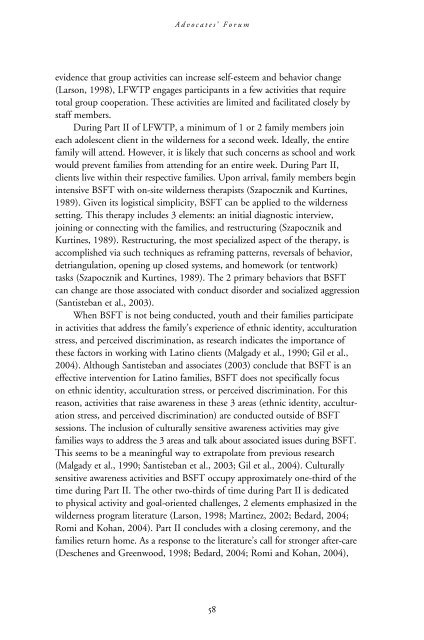2006 - School of Social Service Administration - University of Chicago
2006 - School of Social Service Administration - University of Chicago
2006 - School of Social Service Administration - University of Chicago
You also want an ePaper? Increase the reach of your titles
YUMPU automatically turns print PDFs into web optimized ePapers that Google loves.
Advocates’ Forum<br />
evidence that group activities can increase self-esteem and behavior change<br />
(Larson, 1998), LFWTP engages participants in a few activities that require<br />
total group cooperation. These activities are limited and facilitated closely by<br />
staff members.<br />
During Part II <strong>of</strong> LFWTP, a minimum <strong>of</strong> 1 or 2 family members join<br />
each adolescent client in the wilderness for a second week. Ideally, the entire<br />
family will attend. However, it is likely that such concerns as school and work<br />
would prevent families from attending for an entire week. During Part II,<br />
clients live within their respective families. Upon arrival, family members begin<br />
intensive BSFT with on-site wilderness therapists (Szapocznik and Kurtines,<br />
1989). Given its logistical simplicity, BSFT can be applied to the wilderness<br />
setting. This therapy includes 3 elements: an initial diagnostic interview,<br />
joining or connecting with the families, and restructuring (Szapocznik and<br />
Kurtines, 1989). Restructuring, the most specialized aspect <strong>of</strong> the therapy, is<br />
accomplished via such techniques as reframing patterns, reversals <strong>of</strong> behavior,<br />
detriangulation, opening up closed systems, and homework (or tentwork)<br />
tasks (Szapocznik and Kurtines, 1989). The 2 primary behaviors that BSFT<br />
can change are those associated with conduct disorder and socialized aggression<br />
(Santisteban et al., 2003).<br />
When BSFT is not being conducted, youth and their families participate<br />
in activities that address the family’s experience <strong>of</strong> ethnic identity, acculturation<br />
stress, and perceived discrimination, as research indicates the importance <strong>of</strong><br />
these factors in working with Latino clients (Malgady et al., 1990; Gil et al.,<br />
2004). Although Santisteban and associates (2003) conclude that BSFT is an<br />
effective intervention for Latino families, BSFT does not specifically focus<br />
on ethnic identity, acculturation stress, or perceived discrimination. For this<br />
reason, activities that raise awareness in these 3 areas (ethnic identity, acculturation<br />
stress, and perceived discrimination) are conducted outside <strong>of</strong> BSFT<br />
sessions. The inclusion <strong>of</strong> culturally sensitive awareness activities may give<br />
families ways to address the 3 areas and talk about associated issues during BSFT.<br />
This seems to be a meaningful way to extrapolate from previous research<br />
(Malgady et al., 1990; Santisteban et al., 2003; Gil et al., 2004). Culturally<br />
sensitive awareness activities and BSFT occupy approximately one-third <strong>of</strong> the<br />
time during Part II. The other two-thirds <strong>of</strong> time during Part II is dedicated<br />
to physical activity and goal-oriented challenges, 2 elements emphasized in the<br />
wilderness program literature (Larson, 1998; Martinez, 2002; Bedard, 2004;<br />
Romi and Kohan, 2004). Part II concludes with a closing ceremony, and the<br />
families return home. As a response to the literature’s call for stronger after-care<br />
(Deschenes and Greenwood, 1998; Bedard, 2004; Romi and Kohan, 2004),<br />
58
















